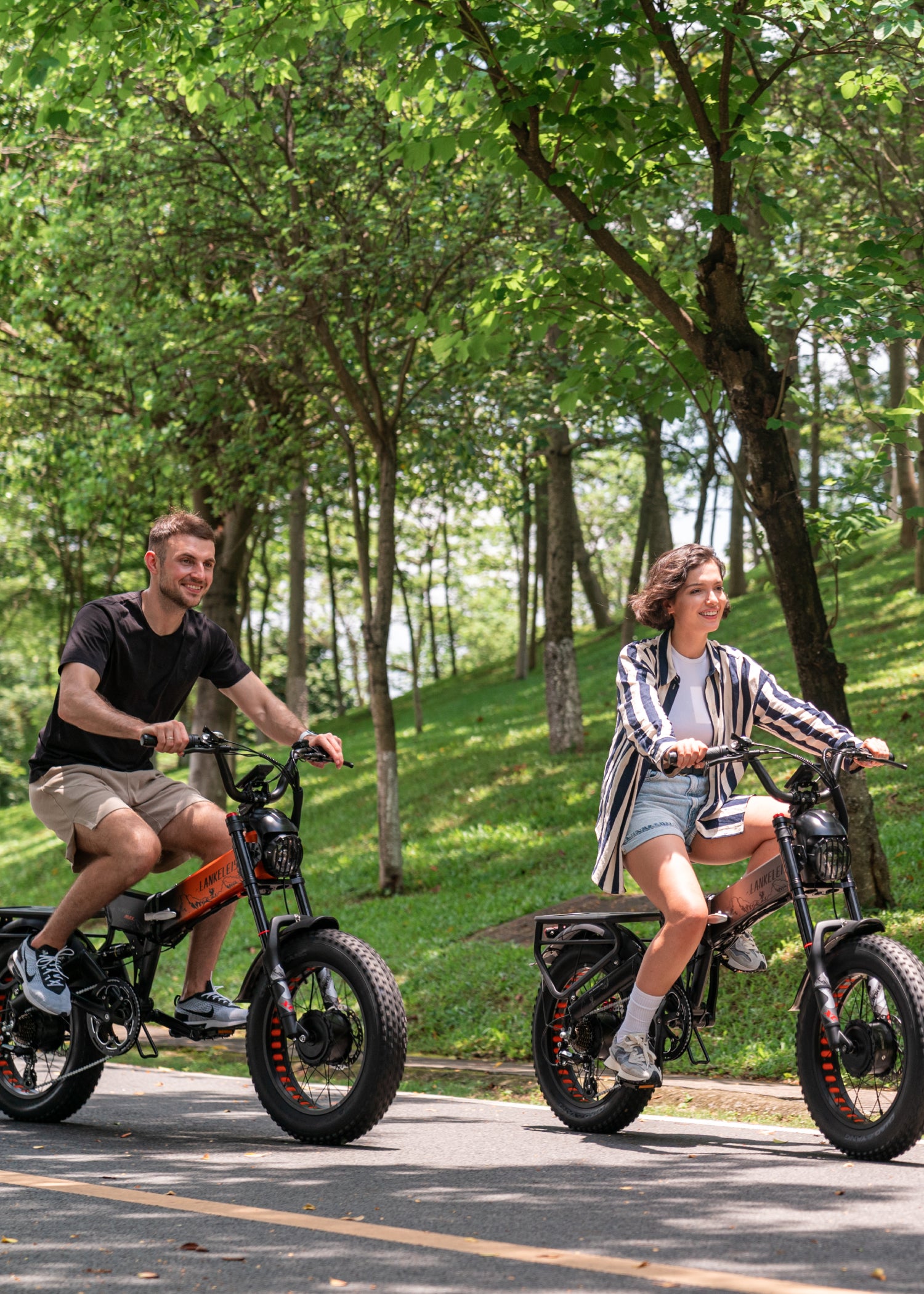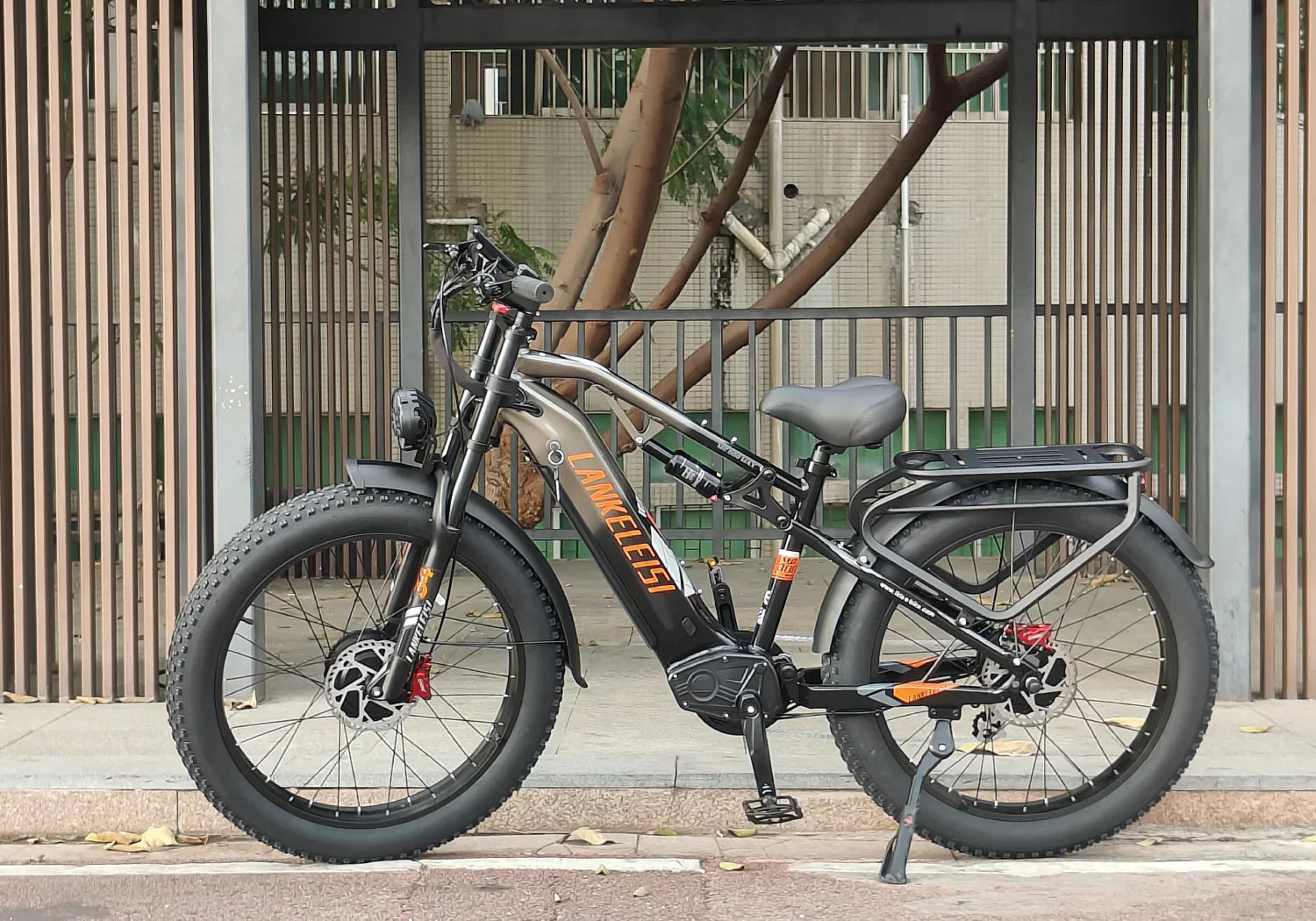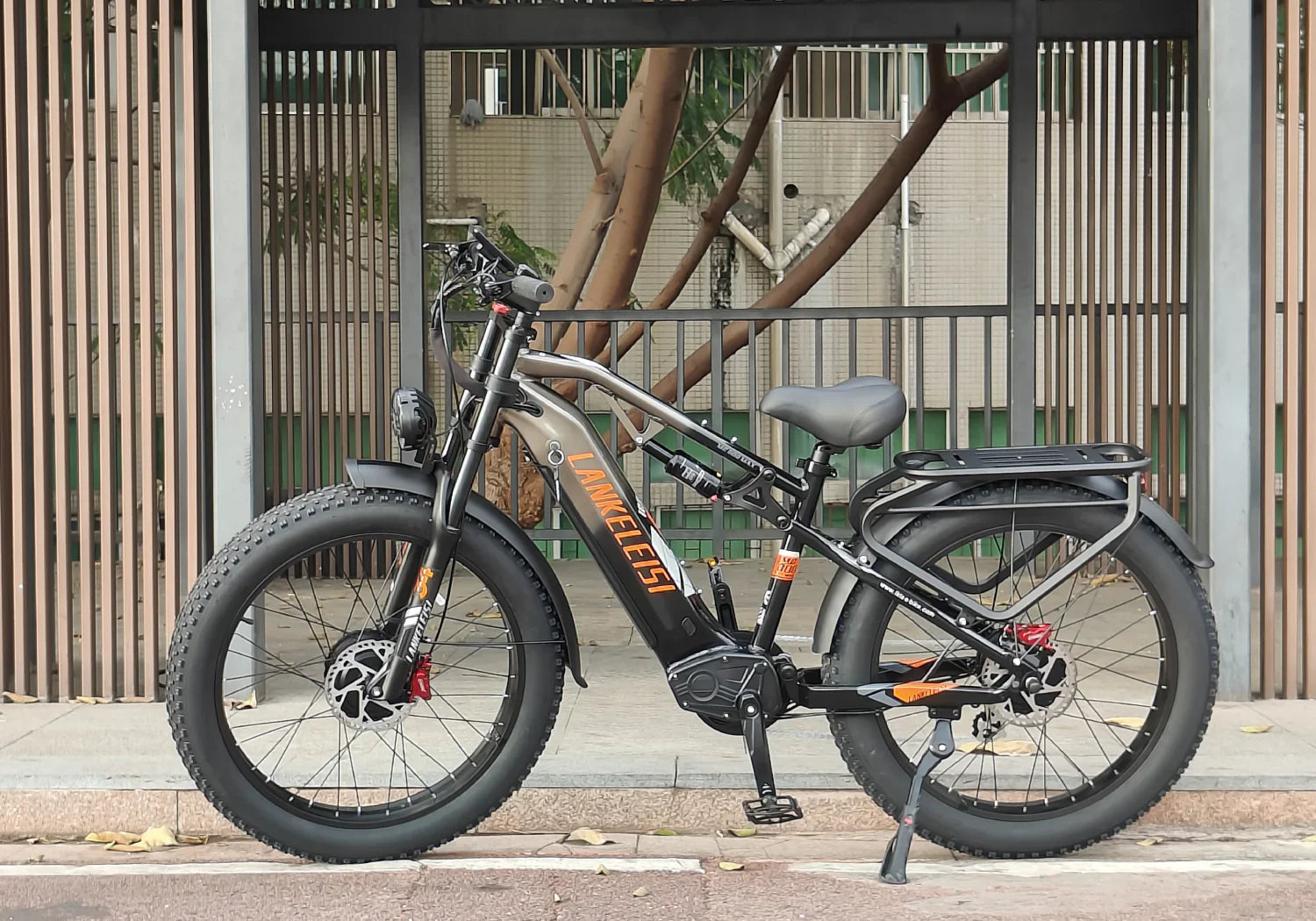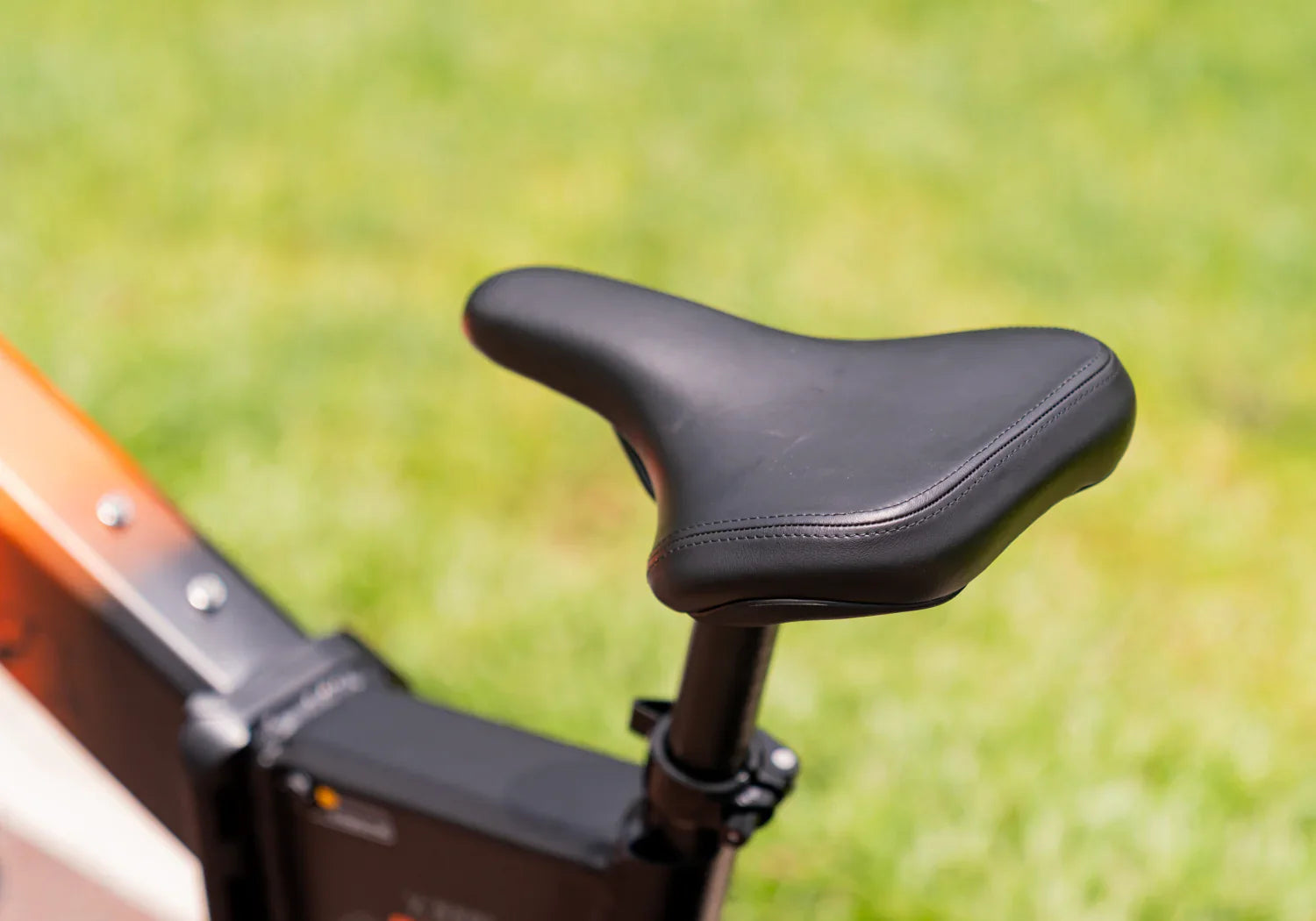As an emerging mode of transportation, electric bikes are practical, environmentally friendly, and economical. Whether you're an adventure enthusiast or a daily commuter, understanding the working principles of electric bikes can better help you choose and use them correctly.
In this article, you will get a quick overview of how an electric bike works, its advantages and disadvantages, among other things.
Still hesitant about getting an electric bike? Read on to learn everything you need to know to make the right choice!
Main components of an electric bike
Electric bikes are mainly composed of core parts such as frames, motors, batteries , control systems, transmission systems and braking systems.
Among them, the motor is the power source of the electric bicycle, the battery is an electrical energy storage device, the control system is responsible for coordinating the operation of various components, the transmission system transmits the power from the motor to the wheels, and the braking system is used to control the stopping of the vehicle.
The basic operating principle of electric bicycles
Battery powered
Electric bike batteries are usually lithium-ion or lead-acid batteries, which can store large amounts of electrical energy.
When you start your electric bike, the battery powers the motor through the control system. The battery's output voltage and current will directly affect the energy performance and range of the electric bike.
Control system coordination
An e-bike's control system is the brains of the entire vehicle. It is responsible for receiving operating instructions from the user and adjusting the motor's output power and speed based on factors such as battery power, motor condition, and vehicle riding conditions.
The control system usually includes components such as the main controller, speed sensor, throttle sensor, brake sensor , etc., which work together to ensure the smooth operation of the electric bike.

The transmission system transmits energy
The drivetrain of an electric bike consists mainly of components such as chains , gears and flywheels , which transfer power from the motor to the wheels .
When you turn the handlebars, the control system instructs the motor to provide the appropriate power, which is then transmitted to the wheels through the transmission to move the vehicle forward.
Controlled shutdown of the braking system
The braking system of electric bicycles generally adopts a double brake design at the front and rear, including hand brake and foot brake.
When you need to stop the vehicle, you can prevent the wheels from turning by using the braking system to stop the vehicle.
The braking system is also equipped with an anti-lock function, which ensures that the wheels do not completely lock during emergency braking, thus improving driving safety.
How does an electric bike motor work?
An electric bike is powered by a battery that drives the wheels through a motor to enable movement.
The motor is the central component of an electric bike, powering the wheels by converting electrical energy into mechanical energy. The operating principle of an electric bike motor is similar to that of a DC motor, but since the power source of an electric bike is solely the battery, the motor's speed and torque control must be adapted to different road conditions and operating states.

How engines work
The armature
The armature is the most important part of the motor and the one that directly drives the wheels. It consists of a series of magnets and windings. When current passes through the armature windings, it creates a magnetic field and distributes the magnetic lines of force across the stator.
When the current in the armature windings changes direction, the polarity of the magnetic field changes. This creates a reversing force between the current in the armature windings and the stator magnetic field, which drives the wheel.
Brooms
The brushes are the part that connects the power supply to the motor windings.
Brushes are made of one or more graphite conductive materials and must be pressurized to ensure proper contact with the motor windings. Only when the brushes touch the motor windings does current flow from the power supply to the windings.
Source of potential
The power source is the part of the e-bike used to provide power. Most e-bikes use lithium-ion batteries to provide the electrical energy needed to drive the motor. The power source provides power to the motor, which drives the wheels.
How it is implemented
Electric bikes can use either DC or AC motors to drive the wheels. The main mode used by the e-bikes currently on the market is DDABC (D represents the DC motor, A represents the switching power supply, B represents the motor controller, and C represents the battery).
Motor drive
Electric bicycles are powered by both DC and AC motors. The advantages of DC motors are their simple structure, easy control, easy adjustment of output torque and speed, and high power conversion efficiency. The disadvantages of DC motors are that they require brush maintenance and that some motors accelerate too quickly and are difficult to control.
AC motors are currently the most popular and widely used drive method for electric bicycles.
AC motors are divided into asynchronous and synchronous motors. The latest electric bikes use brushless DC motors. Compared to traditional brushed motors, brushless motors are modular in design, have a simpler structure, and are more efficient.
Battery
Electric bikes use lithium-ion batteries because they are small, lightweight, well-matched to the motor, and have advantages such as fast charging and low self-discharge.
At the same time, it also has good service life and durability, and can generally be used for more than 4-6 years.
Motor controller
The motor controller mainly controls the speed and torque of the electric bicycle by controlling the current and voltage to control the output of the motor.
The motor controller has functions such as current regulation, speed regulation, and protection. Its main control objects are the motor and battery of the electric bicycle, which must be reasonably adjusted according to actual needs.
Is it possible to ride an electric bike without electric assistance?
Electric bikes are generally heavy due to the motor and battery, and can be more difficult to pedal when the assist is turned off. The extra weight is especially noticeable when climbing hills or starting off.
However, some models are designed to be used more unassisted. Electric bikes with removable electric motors and high-performance drivetrains offer a more natural feel when pedaling unassisted.
Riding without assistance can save battery life or increase range on long journeys. It's also a great way to exert more physical effort while still being able to intervene if needed.
Advantages of electric bicycle motorization
Save energy. Compared with traditional fuel vehicles, electric bicycles can maximize energy conservation and ensure environmental quality of life.
Green and environmentally friendly. Electric bikes require no oil or grease, produce no exhaust fumes or noise, and are a low-carbon, environmentally friendly mode of transportation.
Reduced operating costs. The cost of recharging an electric bike is much lower than that of a gasoline-powered vehicle. After optimization and improvement, the vehicle offers significant advantages over gasoline-powered vehicles in terms of performance and economy.
How does an electric bike battery work?
An electric bike battery is an energy accumulator that powers the electric motor to provide pedal assistance. It stores electrical energy in chemical form and releases it gradually according to the cyclist's needs.
Most electric bikes use lithium-ion batteries, and LANKELEISI uses 48V 20Ah lithium batteries , etc. This type of battery is appreciated for its lightness, long lifespan, and energy savings. This type of battery offers a good balance between range, performance, and charging time.
Its operation is based on an electronic system that regulates the energy delivered to the motor. The controller manages the power supplied according to the selected assistance level and sensor data (speed, pedaling effort, terrain gradient).
To maximize battery life, it is recommended to avoid deep discharge, not expose it to extreme temperatures, and charge it with the manufacturer's supplied charger.

Different types of electric assistance for bicycles
Electric bikes mainly use different systems to integrate pedal assistance. There are two main technologies: non-proportional electric assistance based on pedal sensors and proportional electric assistance based on pressure sensors. Each model offers a different riding experience.
Pedal sensor
The pedal sensor primarily detects whether the cyclist is pedaling and starts the motor accordingly. The intensity of the assistance does not vary depending on the effort applied, but is determined by the selected mode (low, medium, or high).
It offers a smooth ride and requires no special effort. It is ideal for urban commuters and cyclists looking for constant assistance without too much adjustment.
However, this technology can lack responsiveness, especially when starting off or going uphill, because the motor cannot adapt to the force applied to the pedals.
Pressure sensors
Also known as a torque sensor, the pressure sensor measures the force applied to the pedal and adjusts the assistance accordingly. The harder the rider pedals, the more power the motor delivers, providing a more natural and responsive pedaling feel.
This assistance is particularly useful for sporty or hilly rides, as it optimizes the effort according to the terrain. It also extends battery life, as the assistance system can be precisely adapted to the rider's needs.
What type of sensor should I choose?
It depends on your riding style. If you only use it in the city, you can opt for a pedal assist sensor. . If you want better control and a more natural feel, such as on rough terrain, mountain roads, etc., it is recommended to use a pressure sensor.
Advantages and disadvantages of electric bikes
Although electric bikes have many advantages, it is also because of these advantages that they are loved by many cycling enthusiasts. However, electric bikes also have some disadvantages. Here is a brief introduction to the pros and cons of electric bikes.
Advantage
- Pedal assistance: Reduces physical effort, ideal for long distances and climbs. It allows you to ride without breaking a sweat, which is very suitable for daily commuting;
- Speed and efficiency: Easily reach maximum travel speeds;
- Autonomy and autonomy: sufficient for longer trips in the city and long journeys without feeling tired;
- Environmental protection: no carbon dioxide emissions, thus helping to reduce pollution;
- Comfort and accessibility: With a more stable full suspension system, it ensures driving comfort;
- Versatility: Suitable for different terrains, such as daily commuting, urban roads, rugged mountain roads or country roads.
Disadvantages
- Weight: Heavier than traditional bikes;
- Charging time: Charging time varies by model;
- High initial cost: more expensive than traditional bicycles (there are suitable aids and subsidies in French regions);
- Regular maintenance is required: Regular maintenance is required at a later stage, such as maintenance of batteries, motors, sensors, etc.
Find the best electric bikes
Finding a high-performance electric bike will not only enhance your riding experience, but also ensure your safety during your ride. There are several criteria to consider for high-performance electric bikes, such as motor power, range, comfort, and component quality.
Among the brands recognized for their reliability and innovation, LANKELEISI stands out for its high-end models adapted to urban travel and rough terrain, and appreciated by many cycling enthusiasts.
Why choose LANKELEISI electric bike?
Power and performance. The LANKELEISI electric bike is equipped with two powerful motors, 1000W motors at the front and rear, which can provide rapid acceleration and optimal assistance on steep slopes.
Long battery life. LANKELEISI is equipped with a Samsung 48V 20Ah lithium battery. Adopt 21700 battery cells, optimize the size and increase the battery capacity.
Durable and comfortable. It adopts an aluminum alloy frame, hydraulic suspension and off-road tire design to ensure a smooth ride on various road surfaces.
Versatility. Whether for city, mountain, or long-distance hiking, LANKELEISI can provide models suited to various needs. You can visitLANKELEISI's official website to view the relevant models.
LANKELEISI bikes are equipped with a smart LCD display , multiple assistance levels and a high-performance braking system to ensure the best riding experience.

Our selection of LANKELEISI electric bikes
X3000 MAX is a folding electric bike with two powerful motors and designed to conquer any terrain with ease.
The XT750 PLUS is an all-terrain electric bike with improved range. Equipped with a 48V 1000W motor and 26*4.0 wide tires, it allows you to easily traverse rough roads.
The new GOLF-X electric bike is now available, a versatile folding urban electric bike designed for both urban commuting and off-road adventures.

To summarize
Electric bikes have become an alternative to traditional modes of transportation. Thanks primarily to their high-performance motor, long-lasting battery, and intelligent assistance, they can help you ride more easily and comfortably. Therefore, an electric bike will be an ideal choice for your daily commute and easy long-distance travel.
FAQ
What is the power source of an electric bike?
Its power source is a rechargeable lithium-ion battery. Because the battery stores electrical energy to power the electric motor, which provides pedal assistance.
How far can an electric bike travel without pedaling?
In Europe, most e-bikes require active pedaling to activate the motor.
What is the maximum speed of an electric bike?
Electric bicycles (E-bikes): The speed limit in Europe is 25 km/h. Beyond this, the assistance disappears and you have to pedal independently.
High-speed bicycles (fast VAE): can go up to 45 km/h, but require approval, insurance and a suitable helmet.







